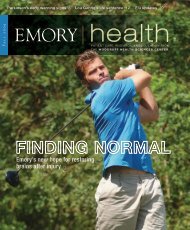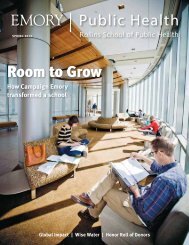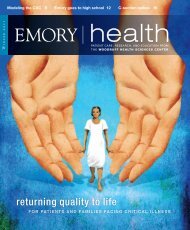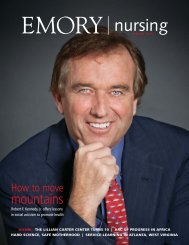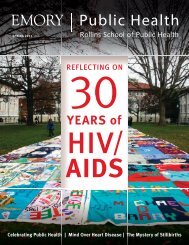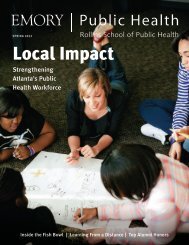medicine - Woodruff Health Sciences Center - Emory University
medicine - Woodruff Health Sciences Center - Emory University
medicine - Woodruff Health Sciences Center - Emory University
Create successful ePaper yourself
Turn your PDF publications into a flip-book with our unique Google optimized e-Paper software.
2<br />
Dean’s Message<br />
EMORY MEDICINE<br />
During summer, the Atlanta Veterans Affairs Medical <strong>Center</strong> (VAMC) is barely<br />
visible from <strong>Emory</strong>’s Lullwater Preserve. The center is obscured by the thick<br />
tangle of trees along Peachtree Creek, the natural dividing line between our campuses.<br />
But the ties between the School of Medicine and the VAMC run deep.<br />
Our partnership began more than 50 years ago when the U.S. government first encouraged<br />
VA hospitals to affiliate with medical schools as a way to raise the level of medical<br />
care for veterans. Today, the VAMC annually treats more<br />
In all, more than<br />
than 60,000 veterans who are seen primarily by <strong>Emory</strong><br />
400 <strong>Emory</strong> investi-<br />
physicians.<br />
gators are engaged<br />
The center also provides a rich training ground for<br />
in approximately<br />
medical students, residents, and fellows. During the past<br />
150 research proj-<br />
two years, the VAMC increased its support for graduate<br />
ects at the VAMC,<br />
medical education by 14% and will provide an additional<br />
which ranks consis-<br />
2% next year.<br />
tently near the top<br />
In all, more than 400 <strong>Emory</strong> investigators are engaged<br />
10 of VA centers<br />
in approximately 150 research projects at the VAMC, which<br />
in research dollars<br />
ranks consistently near the top 10 of VA centers in research<br />
received.<br />
dollars received. Among the researchers who thrive there<br />
is David Guidot, director of the <strong>Emory</strong> Alcohol and Lung Biology <strong>Center</strong> (see the story<br />
about his research on page 8). The VAMC is also home to top research centers in geriatrics,<br />
HIV/AIDS, and rehabilitation <strong>medicine</strong>. Their work is complex but their goal is<br />
simple: to serve the nation’s heroes today and improve health care for past, present, and<br />
future veterans.<br />
Several years ago, the bridge that once joined our campuses was removed. This summer,<br />
VAMC director James Clark and I were among those who dedicated a new bridge<br />
over Peachtree Creek that once again links us. Designed to blend with its natural environs,<br />
the suspension bridge makes our campuses more pedestrian friendly. But for those of us<br />
in the School of Medicine, the bridge takes on deeper significance as physicians, scientists,<br />
residents, students, and others cross back and forth between our co-joined worlds and<br />
with every crossing make a difference in patient care and research, now and in the future.<br />
Sincerely,<br />
Thomas J. Lawley<br />
Dean<br />
In Brief<br />
Ramping up health care<br />
<strong>Emory</strong> has ramped up an earlier plan to expand its<br />
patient care and research facilities.<br />
This summer, the Board of Trustees approved<br />
a $73 million proposal that includes replacing <strong>Emory</strong><br />
<strong>University</strong> Hospital with a new hospital. Two years ago,<br />
<strong>Emory</strong> announced plans to construct a new <strong>Emory</strong> Clinic<br />
complex, along with a replacement for <strong>Emory</strong> Hospital,<br />
to be located and built in phases across Clifton Road<br />
from the hospital’s current site. The new proposal calls for<br />
expanding facilities at <strong>Emory</strong><br />
Crawford Long Hospital in<br />
Expansion of the Midtown<br />
Midtown, which was not part<br />
campus includes the addi-<br />
of the 2006 plan.<br />
tion of 125 new hospital<br />
New Clifton Road facili-<br />
beds, a 137,000-square-foot<br />
ties now include a 250-bed<br />
<strong>Emory</strong> Clinic building, and<br />
hospital, replacing 100 beds<br />
75,000 square feet of new<br />
currently in <strong>Emory</strong> Hospital<br />
research space.<br />
for a net gain of 150 beds;<br />
a new 395,000-square-foot<br />
<strong>Emory</strong> Clinic to be built next to the current clinic; a larger<br />
emergency department in the new hospital; and a new<br />
100,000-square-foot research building across from the<br />
<strong>Emory</strong>-Children’s <strong>Center</strong>.<br />
Expansion of the Midtown campus includes the addition<br />
of 125 new hospital beds, a 137,000-square-foot<br />
<strong>Emory</strong> Clinic building, and 75,000 square feet of new<br />
research space.<br />
The new proposal is founded on several years of planning<br />
guided by community input to create a more integrated<br />
approach to health care that can respond nimbly to<br />
patient demand.<br />
From mouse to monkey<br />
Scientists at Yerkes National<br />
Primate Research <strong>Center</strong><br />
and the Department of<br />
Human Genetics have<br />
developed the first transgenic<br />
nonhuman primate<br />
model of Huntington’s disease<br />
(HD).<br />
Until now, researchers<br />
used transgenic mice to<br />
study HD, but the models<br />
did not completely parallel<br />
the brain changes and<br />
behavioral features that<br />
characterize people with the<br />
inherited disorder. Patients<br />
experience uncontrolled<br />
movements, loss of mental<br />
processing capabilities, and<br />
emotional disturbances.<br />
“The transgenic monkeys<br />
provide us with unparalleled<br />
opportunities for<br />
assessments that mirror the<br />
ones used with humans,”<br />
says lead researcher<br />
Anthony Chan. “With such<br />
information, much of which<br />
Pediatric powerhouse<br />
Children’s <strong>Health</strong>care of<br />
Atlanta has designated<br />
$430 million from its<br />
endowment to create<br />
a pediatric research<br />
powerhouse involving<br />
<strong>Emory</strong>, Georgia Tech,<br />
and other research and<br />
academic institutions<br />
in Georgia.<br />
Over time, the<br />
investment will change<br />
the pediatric research<br />
landscape, especially in<br />
areas such as heart disease, oncology, and neuroscience.<br />
Additionally, the partnership will attract top medical talent<br />
and grants as well as prime the pump for start-up<br />
companies to help develop new treatments and vaccines.<br />
The initiative opens the door to further collaboration<br />
between <strong>Emory</strong> and Children’s. Since 2004, pediatric<br />
researchers, clinicians, and teachers have lived under one<br />
roof in the building that houses the <strong>Emory</strong>-Children’s<br />
<strong>Center</strong> (ECC) on the Egleston campus. In 2006, <strong>Emory</strong> and<br />
Children’s agreed to operate ECC jointly as the largest<br />
pediatric multispecialty group practice in Georgia.<br />
we are obtaining by using<br />
Yerkes’ imaging capabilities,<br />
we are developing a more<br />
comprehensive view of the<br />
disease.”<br />
The researchers believe<br />
their progress bodes well<br />
for developing transgenic<br />
monkey models of other<br />
neurodegenerative diseases,<br />
such as Alzheimer’s and<br />
Parkinson’s. In the case<br />
of HD, such models may<br />
bring hope to the<br />
five to 10 people in every<br />
100,000 who are affected.<br />
Patients succumb to the<br />
disease within 10 to 15<br />
years of symptom onset.<br />
FALL 2008 3



